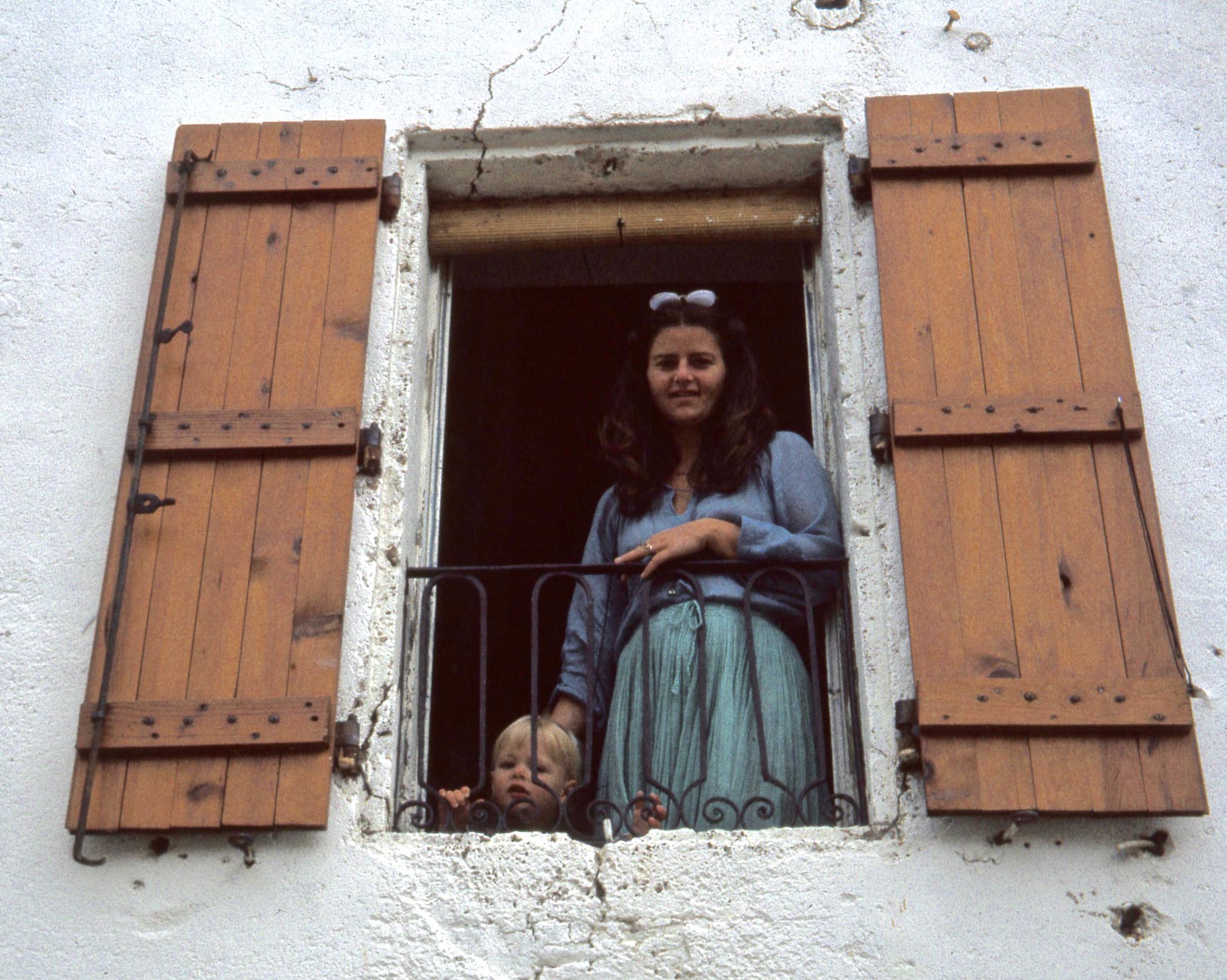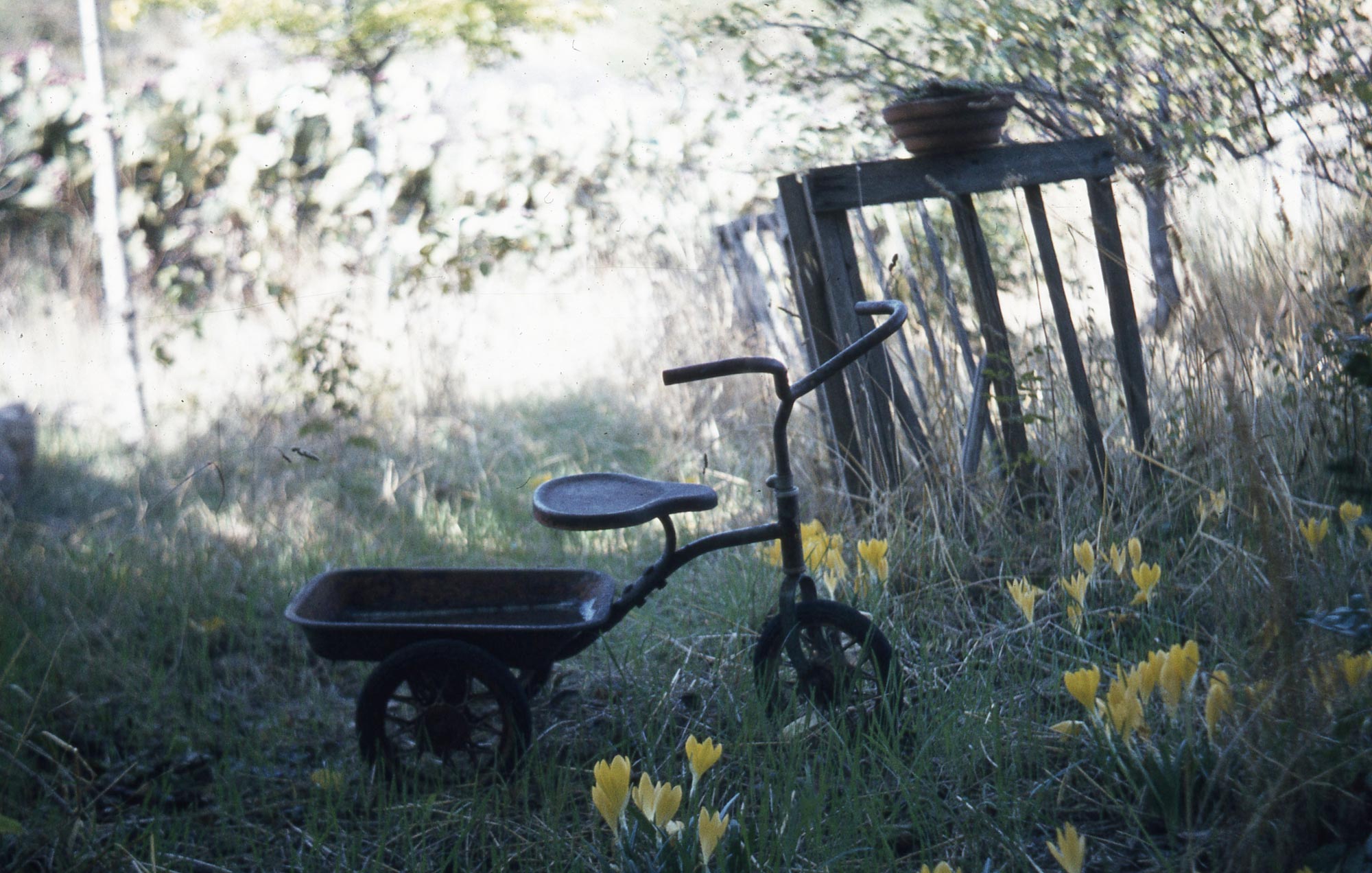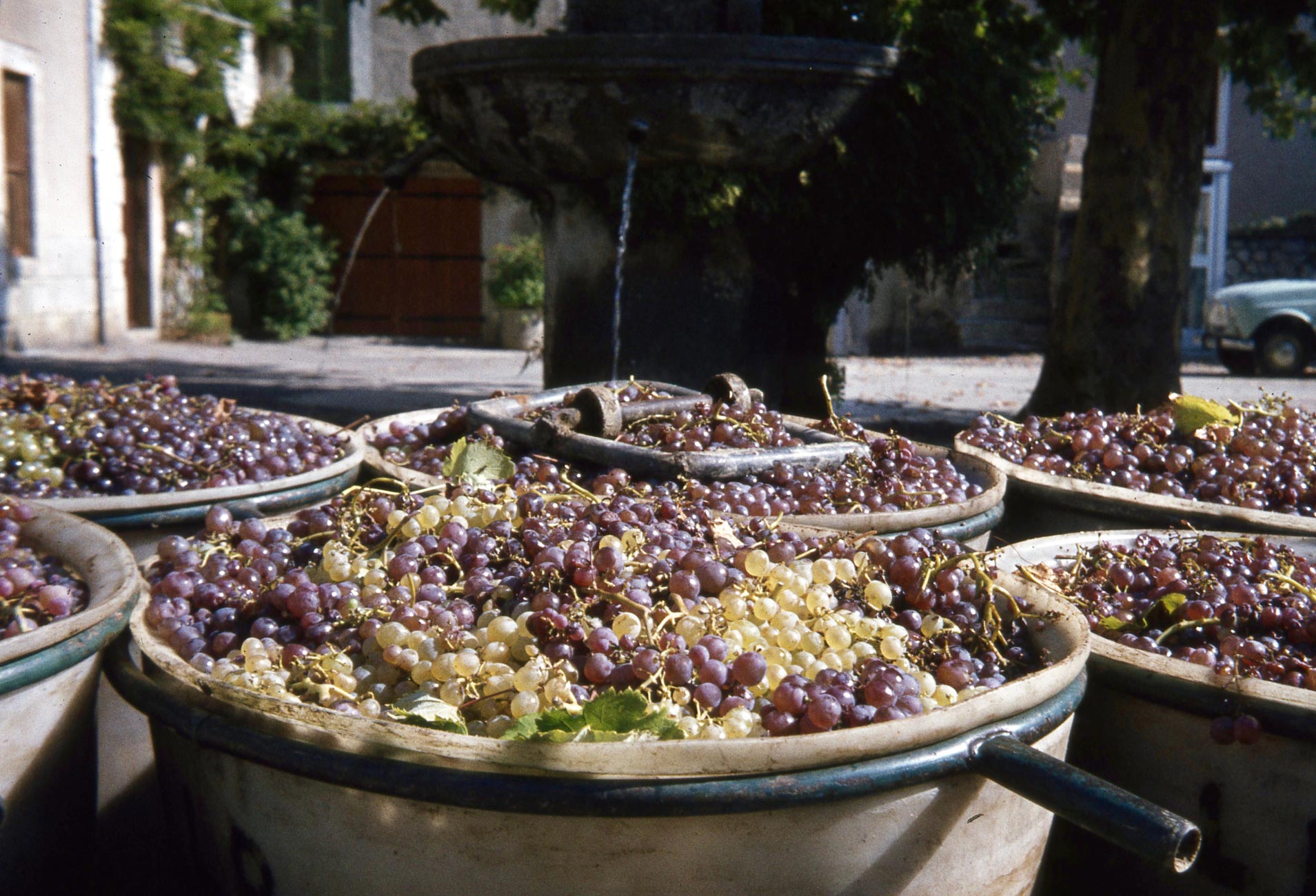During a French holiday in September and October 1981. We shared a house in Cabrieres, Languedoc with Jessica’s friend, Sue Sproston. The house belonged to a colleague of Sue’s who was in the process of renovating it, but hadn’t been too bothered about fixing potential leaks in the roof. Trust us to experience the worst thunderstorm locals could remember.
Here, Jessica and Sam see me off on a trip for the obligatory croissants from the boulangerie.
I found the local gardens fascinating. Some were carefully tended;
others seemed to be spaces to park trucks
or trikes.
Here Sue joins Jessica and Sam in investigating the local lake.
It was clearly the time of the vendanges, or the grape harvest.
We drove around the area and visited a number of villages, like the beautifully kept St Guilhem,
and the almost abandoned Villeneuvette, where Sam sloshed in the fountain, not as elaborate as the one in the grapes picture.
Wikipedia has this to say about Colbert’s social and economic experiment:
‘Villeneuvette is a commune in the Hérault department in the Languedoc-Roussillon region in southern France.
It lies close to the town of Clermont l’Hérault.
Villeneuvette is a small village made up of a group of buildings initially erected in the 17th century to create a royal clothmaking factory and provide accommodation for its workers. Apart from a hotel and restaurant, the buildings are now restricted to residential use, many for holiday purposes.
Creation of Villeneuvette was promoted in 1677 by Jean-Baptiste Colbert the noted finance minister of King Louis XIV. It was one of his many initiatives to develop France’s industrial base. Power for the factory was hydraulic with water supplied via different water courses from existing basins. The factory was privately owned and produced cloth for the king including uniforms for his armies. The factory was in existence until 1955.
Since 1995 the village has been classified as a “Zone de Protection du Patrimoine et du Paysage” recognising the originality and importance of its heritage.
The original inscription above the gateway was “MANUFACTURE ROYALE” but was later rather crudely changed by the Republic to “HONNEUR AU TRAVAIL” – Honour in work.’
When we stumbled across the commune most dwellings were unoccupied, except for a few people who, to us, appeared to be squatters. We were able to amble around and marvel at the higgledy-piggledy nature of the accommodation, often with one family’s upper rooms above those of the residents below.
In 1982, J.K.J. Thomson published ‘Clermont-de-Lodève 1633-1789’. Since it contains an erudite history of Villeneuvette, I had to buy it. It was, in fact, far too academic for my taste, but I did struggle through it. Interestingly, the book jacket shows the changed inscription mentioned above.
I was, perhaps fifteen years later, rather pleased I had, when one of my consutation clients told me that a couple of her friends had bought one of the residences which were now being sold on the open market. I was able to describe what we had seen, and to hand over the book. I didn’t expect to see it again, but, it was eventually returned to me by the wife, who happened to be a committee member of another agency client. Even then, before we were all overtaken by the Web, it was a small world.









You’re a rare and lucky person to get a lent book returned. ????
You have that right! I no longer loan books that I intend to keep.
What is it about books? So many never come back
Yes – it is strange how readers can be so casual about this. Thanks very much, Pat
Such a fascinating place to visit, Derrick. Thank you for sharing your photos. I was intrigued by St Guilhem–those doors in the stone. It looks so medieval. (We just watched the last duel, set in 14th c France.) Congratulations on getting your book back! ?
Thanks very much, Merril. There is a lot of 14th Century in those French villages
You’re welcome, Derrick, and so interesting.
The summer lake foto feels classic Derrick lovely❣️sending joy hedy from snowy etown❄️
Thank you very much, Hedy
Such a lovely reminder of travel days, beautiful photos letting us take part in your memories.
Thank you so much, Agnes
Interesting place
Thanks very much, Sheree. It seemed to be becoming an English holiday enclave
Not necessarily a good thing!
Quite
Sam was just adorable – he must have won the heart of every little French girl he met on that holiday. ?
Thank you so much, AnneMarie X
And every French mom, I bet. He’s adorable!
All wonderful photos, each one beautiful and artistic…and, oh, the special memories…but I have to say…Sam is the highlight for sure! 🙂 What a cutie! 🙂
Some of my fave photos of my own kids were taken from behind…of them in little rompers, pajamas, overalls, corduroy pants, etc. I find that look and view so sweet! 🙂
(((HUGS))) 🙂
Many thanks, Carolyn X
That walkway is intriguing.
It is a good example of those ancient paths in French villages
I have never seen anything like that. I bet the are very interesting to explore.
They are
From the photos, it looks like you had an idyllic holiday there. And such a fascinating history of the place, too! I particularly like the photo of the trike with the yellow flowers.
Thank you very much, Liz. One of my all-time favourite photos
You’re welcome, Derrick. I had a feeling it might be.
I love these photos – so rich in texture and history.
Thanks very much, JoAnna
What a fascinating place! Almost makes this homebody feel like traveling. I wonder how different the area is now.
Yes, Laurie, especially as it seemed to be attracting buyers from over here. Thanks very much
Just as spoken reminiscences kindle past memories, you show here how photographs do the same. You have a well-trained eye for beauty and composition which I enjoy very much.
Thank you very much for these lovely comments, Anne
What a beautiful and charming place. Love the photos of Sam and the one of the three at the lake. St Guilhem–gorgeous. It’s always a shock to me to look back on old photos and count out how long ago it was. Forty years for this series!!! Thanks for sharing.
Much appreciated, Judy. Sometimes when I have produced photographs I have thought they would be history one day – now I am living it
Wonderful memories and photos Derrick
Thank you very much, Aletta
It’s a very French post complete with images of the rural surroundings. I do remember your posts about your efforts to sell off you French residence infested by squatters.
Fortunately that will come later, Uma. Thanks very much
I’m so glad your book was returned.
The other day while entertaining Victoria and family for supper, the subject turned to books. I mentioned my favourite book was ‘Green Darkness’, but it had been missing for around twenty years and I wished I could remember who had borrowed it. Quick as a flash, Victoria answered ‘Oh, that was me, I’ve still got it too!’ Eight years of living under the same roof and I’d no idea that it was sitting on her bookcase!
I knew nothing of this wonderful place, Derrick, so thank you for sharing the history along with your own stunning photos. I adore the one of Sam playing in the fountain. The gardens are magical too. I hope you dried out completely from the crazy storm.
Thanks very much, Alys. Everything soon dried out.
What a beautiful place to stay! I enjoyed reading the story of your time there, Derrick.
Thanks very much, Lavinia
Lovely vacation.
Thanks very much, Sherry
A lovely place to visit! Beautiful photos!
Thank you very much, Ribana
Such beautiful old places. We see very little of that around here (USA). Your family photos are always a treat.
Many thanks, Jodie
<3
Was there a reason you had chosen this particular place to spend your holiday, Derrick?
Just the offer of free accommodation with Jessica’s friend. Thanks very much, Dolly
That’ll do it. My pleasure, Derrick.
What adventures you were able to experience. I was drawn right in, a testimony to your eye and heart in the picture taking. I loved the tiny alleyway, your family, the last one of Sam being a jewel.
Thank you so much, Cynthia
A fascinating history of Villeneuvette. I’d never heard of this place but would have enjoyed a visit when I lived in France. Perhaps one day it could like Saltaire, near Bradford (ie a thriving community).
Who knows, Helen? Thanks very much